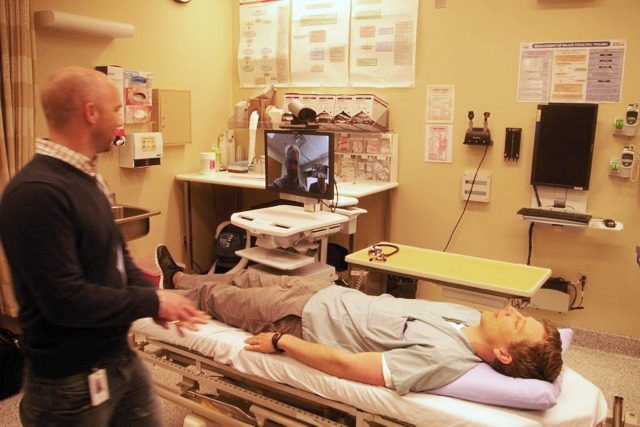New telehealth connections will help save lives
You can’t physically move an entire regional intensive care unit (ICU), but Interior Health is banking on telehealth technology to help.
For hospitals in Kootenay Boundary without an ICU, specialists are using this technology to bring ICU expertise to emergency departments (EDs) in real time to care for critically ill or injured patients.
“It’s statistically proven, not to mention common sense, that the sooner we can get treatment to these patients, the better they do,” said Dr. Scot Mountain, an intensivist at Kootenay Boundary Regional Hospital.
“And the video conferencing equipment is excellent. We can move around the high definition camera remotely from Trail, speak to the ED physicians and nurses face to face, see the patient’s condition directly, and even speak to the patient if they’re conscious.”
With time of the essence a collaborative initiative between Interior Health, the Kootenay Boundary Division of Family Practice, and the Shared Care Committee (a partnership between Doctors of BC and the BC government), now allows consultations for critically ill or injured patients to occur quickly and efficiently with the use of telehealth technology.
A ‘Telehealth Cart’, which features a high definition camera and monitor, enables live video consultations from a patient’s bedside direct to an ICU specialist in Trail. Another camera in Trail completes the live interaction between the two sites.
These new video conferencing connections are being established between emergency departments in Nelson, Nakusp and New Denver with the ICU at Kootenay Boundary Regional Hospital in Trail.
“Telehealth brings services to patients, no matter where they live and is a great example of collaboration and innovation in health care,” said Health Minister Terry Lake.
“We recognize that people living in smaller centres may face unique challenges accessing care and the implementation of these new telehealth connections reflects our strategy to ensure we best meet the needs of patients living in rural and remote communities.”
The result for Dr. Mountain and his colleagues around the region is that they can connect as a team much earlier and work together in a much more efficient way.
“Without this video conferencing, we had to relay our assessment of the patient’s condition by phone,” said Dr. Chuck Burkholder in New Denver.
“We’re trained to do this in the most efficient way, but there is nothing like seeing the patient for yourself. And now we will be able to work together right away with the team in Trail on forming a treatment plan, rather than continually having to relay over the phone.”
The ICU-ED video conferencing project began in the spring of 2016 and has gained rapid traction throughout Kootenay Boundary. For this new service, Interior Health provided technical implementation, training and support, and funded the telehealth carts in Nelson and Nakusp.
The New Denver cart was purchased by the physicians through the provincial Rural Emergency Enhancement Fund (REEF). Shared Care provided funding to the Division for a project lead, software for the physicians, and physician training.
“We agreed to go into this with an open mind as to what technology would work best and we tested multiple options, including iPads, mobile carts and even a robot,” said Loretta Zilm, who manages the Telehealth program for Interior Health.
“With rapidly changing technology, we knew it was very important we considered potential future needs and invest in the most robust solution.”
After testing the options, the doctors chose the Telehealth Mobile Cart.
“All around it was the better solution, and has the ability to connect with other health authorities and includes accessories like a remote stethoscope,” said Dr. Mountain.
The team also had to make sure the solution would be secure, maintain privacy and be reliable. So the system runs over IH’s internal network and a dedicated internet line has been installed in each emergency department.
“While the Telehealth Cart works over WIFI, it can also be plugged in directly if the team is having any issues,” said Zilm.
“I’m excited to see this type of technology become a standard part of the health care we provide to our patients,” said Dr. Mountain.
“We recently used the cart with the ED team in Nelson and I spoke with the patient directly before they were transported to Trail. It meant I wrote my orders for their care four hours earlier than I would have before video conferencing. And when they were feeling better the next day, I spoke to them about their experience and they were not fazed at all by having a doctor treat them virtually with the team in the room.
“The bottom line is that patients are ready for this and I am convinced it will help save lives.”























Comments